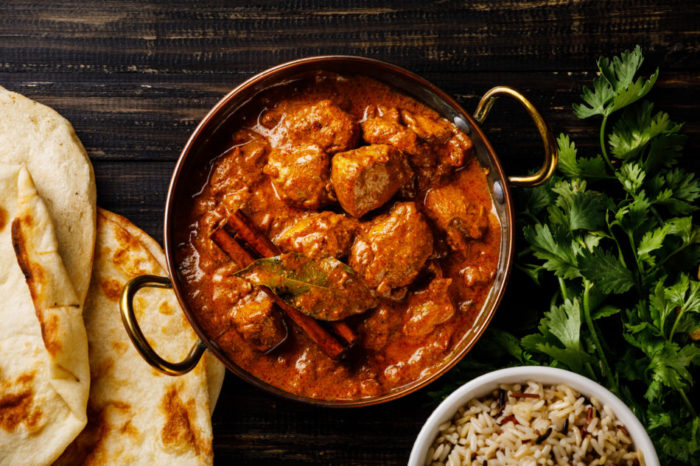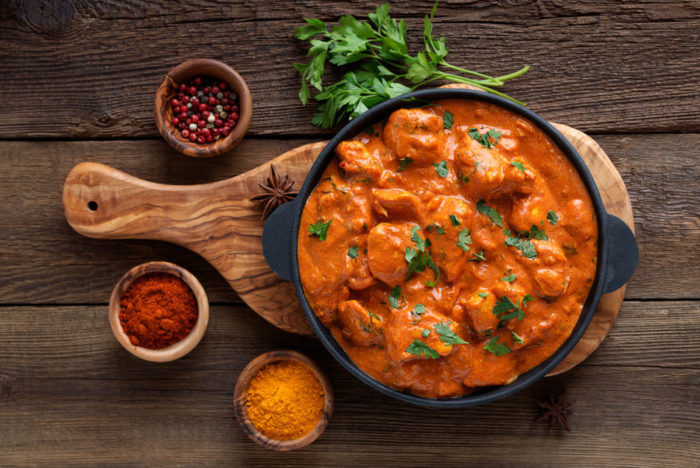

Butter chicken and chicken tikka masala are two very popular examples of Indian cuisine, available globally. If you visit an Indian or Indian-themed restaurant, there’s a good chance you’ll find both these dishes on the menu. And if you eat them, you might find them delightful, but pretty much the same! So what is the deal with butter chicken vs tikka masala?
Is there a difference between these two recipes?
Honestly, the answer depends on who you ask! People often end up talking about origins and histories, but does it really matter? What we’re interested in is how our taste buds appreciate these foods, not in apocryphal tales of chefs stumbling into recipes.
And let’s face it, their color, texture, taste, and feel are very similar. They’re both chicken and curry-based dishes with a largely similar ingredient list. Besides, there is no fixed recipe that provides a clear difference.
Most restaurants follow their own guides and philosophies on the difference between butter chicken and chicken tikka masala. Still, these are two different dishes, so let’s try to make sense of all this and see where the general trend on both these recipes leads us.
What Is Chicken Tikka Masala?

The name here is fairly descriptive of what you can expect from your recipe. There are pieces of chicken and masala for the spice and that delicious curry. And then there’s the unusual term, tikka. Let’s see what that means.
In a general sense, tikka in Indian cuisine means meat (or any other food) cooked on a skewer. In the case of Chicken Tikka Masala, it represents marinated chicken cooked on a skewer. This is somewhat similar to grilling. To some foodies, this represents a major point of difference between the two recipes.
Simply put, Chicken Tikka Masala must use grilled (tikka) meat. This part isn’t necessary for Butter Chicken, so it might feel like an authentic difference. But then again, butter chicken requires marinating and searing while cooking. Many cooks make their job easier and choose to go with chicken tikka (grilled chicken) for either recipe.
What Is Butter Chicken?

Butter chicken is known as Murg Makhani (translate: chicken with butter) in India. As the name implies, this recipe involves chicken served with a rich gravy full of butter. And of course, it has a fair amount of spices and condiments to go along with.
The chicken for this recipe is usually seared, though in some cases, it might be grilled too. It’s placed in a rich curry that’s full of butter and makes generous use of tomatoes and spices for flavor. The chicken itself might be cooked with butter for added flavoring and texture.
Much like the tikka masala, butter chicken too involves using chunks of chicken for cooking. So, rather than having a full chicken, you’re more likely to find pieces or chunks of meat in this recipe.
Putting It All Together
Now that we know the basics of butter chicken and chicken tikka masala, we can talk about some details about these recipes. Conventionally, we’d already have a clear difference at this point. Yet, these recipes are so close, that the differences barely matter. Still, let’s go further with conventional wisdom and trends.
The Bones Have A Story To Tell
Do the bones say something about these recipes? Well, there is some information to consider at this point. The meat in chicken tikka masala isn’t supposed to contain bones. The meat used for this recipe must be boneless and carefully marinated to maintain its texture and taste.
It’s unclear why chicken tikka masala insists on going boneless. However, there is a legend to go along with this. As legends go, this is difficult to verify or confirm. Yet, it might be as good an explanation as any.
Apparently, a Mughal emperor was concerned about choking on chicken bones in his food. So he ordered that all chicken tikka must be deboned before being presented at his table. Some attribute this to the first mughal emperor, while others point to other nobles or emperors. In any case, the legend stays pretty much the same.
Moving on, since chicken tikka (skewered and cooked chicken) became a key ingredient of chicken tikka masala, it carried on with the tradition of staying boneless.
Butter chicken, on the other hand, has no such compunction about bones. While many chefs prefer to serve their recipe deboned, it’s not considered a necessary part of the preparation.
The Curry (Gravy) Could Be Different
Butter chicken and chicken tikka masala bask in the glory of the rich and decadent curry that makes either food. In fact, the key difference in several Indian recipes could very well be the curry (or gravy) that’s employed for the food.
Again, there are no hard rules here. But there is a general view on the difference of the curries for both these recipes.
Butter chicken utilizes a gravy (sauce or curry) that’s creamy and makes generous use of tomatoes and spices. Usually, it shows off a vibrant color with a visible presence of butter.
Chicken tikka masala relies on a rich gravy of tomato and onions, with some presence of oils or butter.
Usually, the difference between their flavors is rather subtle, but chicken tikka masala is more likely to show a more oniony taste.
Let’s Do The Origin Story
Well, I don’t place much stock in the origin story of either of these dishes, but for the sake of being comprehensive, let’s cover that too. Keep in mind, these stories are apocryphal and often hotly contested.
Butter chicken was the brainchild of a trio of food entrepreneurs in India. They were running a food joint in India (around 1947-48) and wanted a way to keep the cooked chicken from drying out.
The innovation resulted in butter chicken and was hugely successful. Continuing with this success, the trio formed the Moti Mahal restaurant in New Delhi, which is now a huge chain with presence all across India.
Chicken Tikka Masala has a similar story, but the venue moves to the UK, or more specifically, an Indian restaurant in the UK. Apparently, the customers in the restaurant complained of how dry the cooked chicken was.
So, the cook (who happens to be a fresh immigrant from India, Pakistan, or Bangladesh, depending on different versions of the story) adds a quick curry to the recipe.
Notice how similar these stories, situations, and events are.
FAQ And More On Butter Chicken And Tikka Masala
How To Make Butter Chicken
This is a complex recipe, but I’ll cover the basics here. The recipe starts with marinating the chicken. Overnight is better, but it must have at least 20 minutes for marinating. Remember to slice the chicken into 1-inch cubes before marinating.
The marinate usually includes yogurt, garam masala, salt, chili powder, turmeric, garlic, and a few other spices.
Sear the marinated chicken in a skillet or pan, and keep it aside. Use the same pan to cook butter chicken sauce (curry). Bits of chicken stuck to the pan and its existing flavor will help with the taste of the curry.
Pour a small amount of oil and add a chopped and diced onion. Follow this with ginger and garlic. This helps caramelize these foods and reduces their strong odors. Follow this with crushed tomatoes, reducing them until they form a paste.
Finally, combine the curry and the chicken for a sumptuous meal!
Is Chicken Tikka Masala Healthy?
Chicken tikka masala is a lot of things, none of which should be objectively considered healthy. This is a decadent and delicious recipe that delves into the generous use of oil/fats, frying, and roasting. The curry too is fairly spicy and full of all kinds of fats and ingredients.
Enjoy this meal for a treat to your taste buds. But there is no way to consider even a half-decent chicken tikka masala as a healthy meal.
Settling The Discussion
Now that we’ve gone into details of the butter chicken vs tikka masala setup, we can accept an important aspect of these dishes. The line dividing these recipes is razor-thin at best and invisible for the most part. The difference is largely subjective and in the opinion of the cook/chef whipping up the recipes.
Yet, we can consider a few general aspects. For example, tikka masala must use boneless chicken, while butter chicken doesn’t necessarily have to follow. Similarly, tikka masala relies on a more onion-flavored curry, while butter chicken favors a curry richer in tomatoes.
